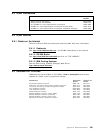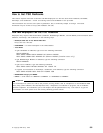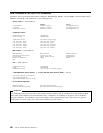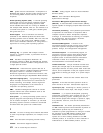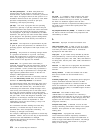B
background partition. In VSE, a space of virtual
storage in which programs are executed under control
of the system. By default, the partition has a
processing priority lower than any of the existing
foreground partitions.
backout. See file and catalog backout.
backup copy. A copy of information or data that is
kept in case the original is changed or destroyed.
base cluster. In systems with VSAM, a
key-sequenced or entry-sequenced file over which
one or more alternate indexes are built. See also
cluster.
base register. (1) A register that holds a base
address. (2) A general-purpose register that a
programmer chooses to contain a base address.
batch application. In VSE, a set of programs that
normally processes data without user interaction; for
example, an application to print a company payroll.
Such an application uses a device, a data file, or the
processor intensively for a longer time than online
applications.
batch execution. Execution of programs and data
that have been submitted or accumulated as batched
input.
batch processing. (1) Loosely, the execution of
computer programs serially. (2) Pertaining to the
technique of executing a set of computer programs
such that each is completed before the next program
of the set is started.
BCP. Base Control Program. This refers to the
″heart″ of the OS/390 operating system without the
JES, RACF, VTAM and other subsystems.
bind. (1) To relate an identifier to another object in a
program; for example, to relate an identifier to a
value, an address or another identifier, or to
associate formal parameters and actual parameters.
(2) To associate a variable with an absolute address,
identifier, or virtual address, or with a symbolic
address or label in a program.
binder. The DFSMS/MVS program that processes the
output of language translators and compilers into an
executable program (load module or program object).
It replaces the linkage editor and batch loader in the
MVS/ESA operating system.
bit string. A string consisting solely of bits.
blocking factor. The number of records in a block. A
blocking factor is calculated by dividing the size of the
block by the size of the record. Synonymous with
grouping factor.
bootstrap. A sequence of instructions whose
execution causes additional instructions to be loaded
and executed until the complete computer program is
in storage.
buffer pool. (1) An area of storage in which all
buffers of a program are kept. (2) In ACF/VTAM, a
group of buffers having the same size. A buffer pool
is established at initialization time in the message
control program; the buffers are built in extents
chained together.
built-in function. (1) A function that is supplied by a
language. (2) In PL/I, a predefined function, such as a
commonly used arithmetic function or a function
necessary to high-level language compilers; for
example, a function for manipulating character strings
or converting data. It is automatically called by a
built-in function reference.
business partner. Any non-IBM organization, with
whom IBM has a written contract defining a
complementary marketing relationship, that provides
end users with information-handling solutions that use
or rely upon an IBM offering.
C
C language. A language used to develop software
applications in compact, efficient code that can be run
on different types of computers with minimal change.
cache. (1) A special-purpose buffer storage, smaller
and faster than main storage, used to hold a copy of
instructions and data obtained from main storage and
likely to be needed next by the processor. (2) A buffer
storage that contains frequently accessed instructions
and data; it is used to reduce access time.
cancel. To end a task before it is completed.
catalog. A collection of all data set information, like
device type and volume serial number, that MVS
needs to locate a specific data set. Using the catalog
simplifies developing MVS JCL that does not change
from one run to the next.
catalog backout. See file and catalog backout.
cataloged procedure. A set of control statements
placed in a library and retrievable by name.
category (of programming elements). A main
classification of programming elements that groups
elements of a single type, such as source modules,
copied members, and macros.
CBPDO. Custom-Built Product Delivery Offering. A
CBPDO is a tape that has been specially prepared for
installing a particular product and the related service
requested by the customer. A CBPDO simplifies
installing a product and the service for it.
Glossary 567



